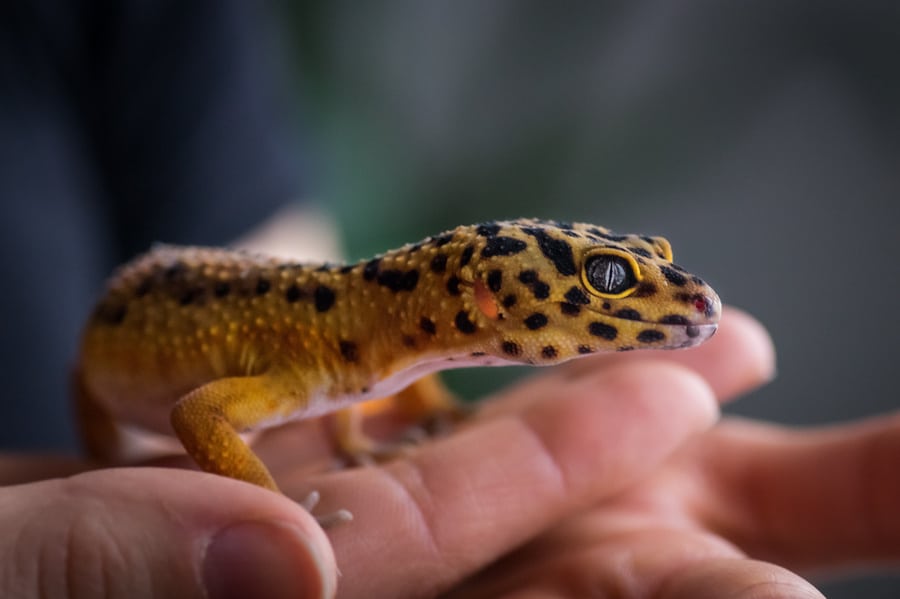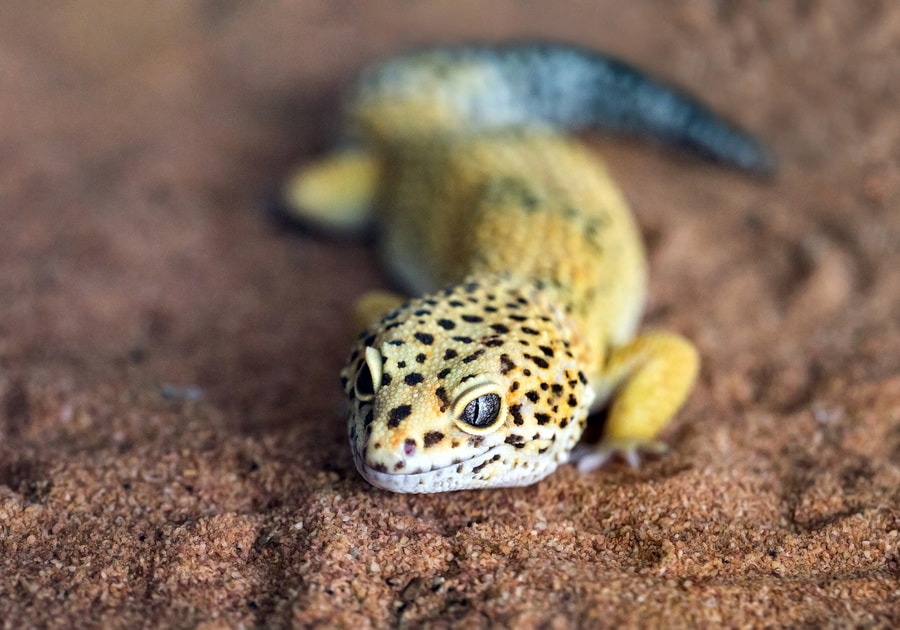As a journalist specializing in leopard geckos, I have delved into the intricacies of their feeding behavior and habits. Understanding the dynamics of feeding competition among leopard geckos is essential for promoting healthy appetite and overall well-being.
Key Takeaways:
- Feeding competition can lead to various issues in leopard geckos.
- Understanding their feeding behavior and habits is crucial for promoting healthy feeding habits.
- Proper husbandry plays a significant role in maintaining a healthy appetite.
- Picky eating can be overcome by offering a variety of feeder insects and ensuring proper husbandry.
- Changes in the living environment can affect a gecko’s eating habits.

Understanding the Impact of Husbandry on Feeding
Proper husbandry plays a crucial role in ensuring the optimal feeding conditions for leopard geckos. A well-maintained terrarium and suitable heating are essential for their overall health and appetite.
Heating Needs
Leopard geckos are ectothermic reptiles, which means they rely on external heat sources to regulate their body temperature. Belly heating is particularly important for their digestive system. Temperature-regulated flooring, such as heat mats or under-tank heaters, should be provided to create a warm surface for the geckos to rest and aid in digestion.
Terrarium Substrate
The choice of terrarium substrate is crucial for leopard geckos. Loose bedding, such as sand or wood shavings, should be avoided as it can lead to impaction if ingested. Instead, opt for non-particulate substrates like reptile carpet or paper towels. These provide a safe and easy-to-clean environment for the geckos.
Creating a suitable living environment for leopard geckos also involves offering appropriate hides and decorations. Hiding spots are essential for reducing stress and providing a sense of security during feeding time. Ensure that the hides are adequately sized for the gecko, allowing them to comfortably retreat and eat without disturbance.
In addition to the physical environment, it’s essential to establish a consistent feeding routine. Leopard geckos thrive on routine and may become stressed or refuse food if there are frequent changes in their feeding schedule or environment.
| Aspect | Recommendation |
|---|---|
| Belly Heating | Temperature-regulated flooring such as heat mats or under-tank heaters |
| Terrarium Substrate | Non-particulate substrates like reptile carpet or paper towels |
| Hiding Spots | Provide appropriately sized hides for a sense of security |
| Feeding Routine | Establish a consistent feeding schedule |
By understanding the impact of husbandry on feeding, leopard gecko owners can ensure that their pets have the best conditions for a healthy appetite and overall well-being.
For a complete breakdown of leopard gecko social behavior, check out this guide. Read this article to learn about leopard gecko juvenile interaction. Read this article to learn about leopard gecko group dynamics.
Dealing with Picky Eaters
Leopard geckos can sometimes be picky eaters, which can be a challenge for their owners. If your leopard gecko won’t eat or is being selective about its food, there are several things you can do to address this behavior and ensure they are getting the nutrients they need.
Firstly, it is important to offer a variety of feeder insects to entice your picky eater. Leopard geckos have different preferences when it comes to the type and size of insects they consume. Some geckos may favor crickets, while others may prefer mealworms or dubia roaches. By providing a selection of feeder insects, you increase the chances of finding something that your gecko finds enticing.
Additionally, it is crucial to ensure proper husbandry for your leopard gecko. Stress and inadequate environmental conditions can contribute to picky eating habits. Make sure the temperature and humidity levels in your gecko’s enclosure are suitable for their needs. Providing proper hiding spots and a comfortable environment can also reduce stress and encourage healthy eating.
Remember that patience is key when dealing with a picky eater. It may take some time for your leopard gecko to adjust to new foods or to overcome any previous negative experiences. Continue offering a variety of feeder insects and monitor their eating habits closely. If you notice any significant changes in behavior or appetite, consult with a reptile veterinarian for further guidance.
Table: Tips for Dealing with a Picky Leopard Gecko
| Tips | Description |
|---|---|
| Offer a variety of feeder insects | Try different types of insects, such as crickets, mealworms, dubia roaches, and waxworms, to see what your gecko prefers. |
| Ensure proper husbandry | Maintain suitable temperature, humidity, and hiding spots in your gecko’s enclosure to reduce stress and promote healthy eating. |
| Monitor eating habits | Keep a close eye on your gecko’s appetite and behavior. If you notice any significant changes, consult with a reptile veterinarian. |
| Be patient | It may take time for your gecko to adjust to new foods or overcome previous negative experiences. Stay consistent and persistent in offering a variety of options. |
By following these tips and giving your leopard gecko time to adjust, you can improve their eating habits and ensure they receive a balanced diet. Remember to provide a comfortable, stress-free environment and consult with a reptile veterinarian if you have any concerns about your gecko’s appetite or overall health.
Addressing Changes in Living Environment
Changes in a leopard gecko’s living environment can have a significant impact on their eating habits. Moving items around in their enclosure, rehoming them, or introducing them to a new tank or location can create stress and cause them to stop eating. As leopard geckos are known for their sensitivity to change, it is crucial to provide them with a familiar and comfortable environment to help them regain their appetite.
When making changes to their living environment, it is important to give leopard geckos time to adjust. Sudden changes can disrupt their routine and make them feel unsafe, leading to a loss of appetite. Gradually introducing new elements or rearranging their habitat can help minimize stress and give them a chance to adapt at their own pace.
Additionally, maintaining a stable temperature and humidity level in their enclosure is essential. Leopard geckos are ectothermic creatures, meaning they rely on external heat sources to regulate their body temperature. Fluctuations in temperature can negatively impact their metabolism and appetite. Providing a heat source such as an under-tank heater or heat lamp can create a warm and comfortable environment for them to thrive.
| Changes in Living Environment | Impact on Leopard Gecko’s Eating Habits |
|---|---|
| Moving items around in the enclosure | Can cause stress and disrupt their feeding routine |
| Introducing them to a new tank/location | Can create unfamiliarity and lead to loss of appetite |
| Rehoming the gecko | Can cause stress and adjustment issues, affecting their appetite |
In conclusion, any changes to a leopard gecko’s living environment can have a direct impact on their eating habits. Giving them time to adapt, maintaining a stable temperature, and ensuring a familiar environment are key factors in helping them maintain a healthy appetite. By addressing changes in their living environment effectively, we can support their overall well-being and promote healthy feeding habits.
Handling Feeder Insects and Superworms
Feeder insects play a crucial role in the diet of leopard geckos. However, some geckos may refuse to eat certain feeder insects if they have had a negative experience, such as being bitten. To ensure a varied and nutritious diet, it is important to offer a selection of feeder insects and observe your gecko’s preferences.
Types of Feeder Insects
Leopard geckos commonly consume crickets, mealworms, superworms, and dubia roaches as feeder insects. Each insect has its own nutritional value, providing different levels of protein, fat, and important minerals. By offering a variety of feeder insects, you can ensure that your gecko receives a balanced diet and all the nutrients it needs for optimal health.
| Feeder Insect | Protein (%) | Fat (%) | Calcium:Phosphorus Ratio |
|---|---|---|---|
| Crickets | 21 | 6 | 1.5:1 |
| Mealworms | 17 | 13 | 1:10 |
| Superworms | 20 | 17 | 1:9 |
| Dubia Roaches | 36 | 15 | 1:1.5 |
As shown in the table, crickets have a higher protein content compared to other feeder insects, while superworms have a higher fat content. Consider the nutritional needs of your leopard gecko when selecting feeder insects and offering a varied diet to meet its requirements.
If your gecko refuses to eat a certain type of feeder insect, it is important to switch it up and try offering a different variety. Some geckos may develop aversions to specific insects due to past negative experiences, so offering alternatives can help encourage feeding.
Addressing Stress and Bullying in Multiple Gecko Setups
When housing multiple leopard geckos together, it is important to be aware of the potential for stress and bullying within the group. This can lead to various issues, including feeding problems. By understanding the dynamics of gecko interactions and implementing appropriate measures, you can create a harmonious environment that promotes healthy feeding habits.
Observation and Behavior
During feeding time, it is crucial to closely observe the geckos’ behavior to identify any signs of stress or aggression. Look for dominant individuals that may be monopolizing food or actively preventing others from eating. Bullying can manifest as chasing, biting, or displacing weaker geckos from food sources.
Separating geckos if necessary is an important step in addressing stress and bullying. If you notice persistent aggression or if certain geckos consistently prevent others from feeding, consider housing them separately to ensure all geckos have access to food and are not under constant stress.
Creating a Suitable Environment
The size of the tank plays a significant role in mitigating stress and bullying. Providing ample space for each gecko to establish its territory can help reduce aggressive behavior. A general rule of thumb is to have a minimum of 10 gallons of space per gecko. Additionally, consider adding multiple hiding spots and visual barriers to create a more secure environment, reducing the likelihood of confrontations during feeding time.
Promoting Healthy Feeding Habits
Offering multiple feeding stations within the enclosure can help minimize competition and ensure that each gecko has access to food. This can be achieved by strategically placing small dishes or shallow containers in different areas of the tank. Additionally, providing a variety of feeder insects and rotating the types offered can help prevent food monopolization and promote healthy feeding habits among geckos.
| Addressing Stress and Bullying in Multiple Gecko Setups |
|---|
| Closely observe gecko behavior during feeding time to identify signs of stress and aggression. |
| Separate geckos if necessary to ensure all individuals have access to food and are not under constant stress. |
| Create a suitable environment with ample space, hiding spots, and visual barriers to reduce aggression. |
| Offer multiple feeding stations and a variety of feeder insects to promote healthy feeding habits. |
Feeding Guide and Nutritional Value of Feeder Insects
Feeder insects play a crucial role in the diet of leopard geckos. They provide the necessary nutrients for their overall health and well-being. Understanding the nutritional value of these feeder insects is essential to ensure a balanced diet for your gecko.
The Nutritional Value of Feeder Insects
Here is a table summarizing the nutritional value of some commonly used feeder insects:
| Feeder Insect | Protein (per 100g) | Fat (per 100g) | Calcium to Phosphorus Ratio |
|---|---|---|---|
| Crickets | 20g | 6g | 1.5:1 |
| Mealworms | 18g | 13g | 1:10 |
| Superworms | 19g | 17g | 1:15 |
| Dubia Roaches | 36g | 5g | 1.5:1 |
It’s important to note that these values are approximate and can vary depending on the individual insects and their diet. When offering feeder insects to your leopard gecko, it is recommended to provide a variety to ensure a diverse nutrient intake.

Leopard Gecko Feeding Guide
When feeding your leopard gecko, it’s crucial to consider their age and size. Juvenile geckos require smaller-sized feeder insects, such as small crickets or small mealworms, as their jaws may not yet be fully developed. Adult geckos can be fed larger insects like adult crickets or superworms.
It’s essential to dust the feeder insects with a calcium and vitamin supplement before offering them to your gecko. This helps to ensure they are receiving the necessary vitamins and minerals for their growth and overall health. Additionally, always provide a shallow dish of fresh water for your gecko to stay hydrated.
Remember that each gecko is unique, and their appetite may vary. Observe their feeding behavior and adjust the quantity of feeder insects accordingly. If you have any concerns about your gecko’s feeding habits or nutritional needs, consult with a reptile veterinarian for guidance.
Conclusion
Feeding competition between leopard geckos can lead to various issues that affect their overall health and well-being. To promote healthy feeding habits in these fascinating reptiles, it is crucial to understand their feeding behavior and address any potential husbandry issues.
By creating a suitable living environment with appropriate heating, substrate, and hiding spots, we can ensure that leopard geckos feel secure and comfortable during feeding time. This helps to minimize stress and encourages a healthy appetite.
Additionally, providing a variety of feeder insects with different nutritional values is essential for a balanced diet. This helps meet their protein, fat, and calcium to phosphorus requirements, promoting optimal health and growth.
Remember, promoting healthy feeding habits in leopard geckos is a continuous effort. By implementing these guidelines and paying attention to their individual needs, we can ensure that these amazing creatures thrive and enjoy a fulfilling feeding experience.
FAQ
How does feeding competition affect leopard geckos?
Feeding competition among leopard geckos can lead to various feeding issues and potential health problems.
What is the impact of husbandry on leopard gecko feeding?
Proper husbandry, including belly heating and suitable terrarium substrate, is crucial for maintaining a healthy appetite in leopard geckos.
How can I deal with a picky eater leopard gecko?
Addressing picky eating behavior involves providing a variety of feeder insects and ensuring proper husbandry.
How do changes in the living environment affect leopard gecko feeding?
Changes in the living environment, such as moving items around or rehoming, can cause stress and affect leopard gecko’s eating habits.
How should I handle feeder insects and superworms?
It is important to offer a variety of feeder insects and switch them up if your leopard gecko refuses to eat a certain type, especially superworms.
How can I address stress and bullying in a multiple leopard gecko setup?
Proper observation of behavior and providing appropriate hiding spots can help minimize stress and promote healthy feeding habits in multiple leopard gecko setups.
What are the nutritional values of feeder insects for leopard geckos?
Feeder insects such as crickets, mealworms, and dubia roaches have different nutritional values, providing protein, fat, and balanced calcium to phosphorus ratios for leopard geckos.
How can I ensure healthy feeding habits in leopard geckos?
Understanding their feeding behavior, addressing husbandry issues, and providing a variety of feeder insects are key to promoting healthy feeding habits in leopard geckos.
References:
- San Diego Zoo
- Article: “Leopard Gecko.”
- Citation: San Diego Zoo
- Oakland Zoo
- Article: “Leopard Gecko.”
- Citation: Oakland Zoo
- Weill Cornell Medical College
- Study: “Social experience affects territorial and reproductive behaviors in male leopard geckos, Eublepharis macularius.”
- Citation: Weill Cornell Medical College
